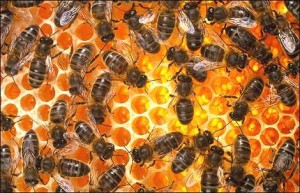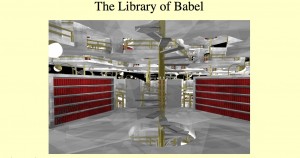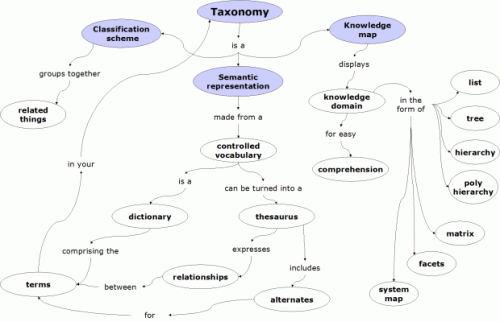A picture is worth … ?
June 15th, 2009
Alternative title: Block That Metaphor
I’ve been working on a presentation that is supposed to give some sense of our own dear CUNY Academic Commons to the outside world, and I have to have the requisite visuals. I thought it might be worthwhile to give folks a sense of what I came up with, though this was with more than a little help from Matt Gold et alia.
First, I wanted to show what the Commons is not. Well, not altogether, anyway. There were competing conceptions that did not quite capture all that we wanted the Commons to be.
Competing Conception #1: A Repository of Stuff. For that, I came up with
and, because Borges’ piece is very much about endlessly receding taxonomies (“To locate book A, consult first book B which indicates A’s position; to locate book B, consult first a book C, and so on to infinity …”), also this:
Few things could suggest, better than these paired images, that the twin challenges of categorization and location for such a “repository of stuff” are dizzying. But if that conception is not the “right stuff,” neither is the whole-hearted focus on social interaction.
Competing Conceptions #2: The Gathering Place, the Agora, the Hub
It’s not enough to bring people together. Even and especially if you do manage to do that, you may only have a crowd.

Sunbathers at Manhattan Beach
Too much lollygagging? Maybe. Alternatively, I pictured it as part marketplace, part traffic jam.

Hyderabad Traffic and Market
The Commons is not (or not just) a place to come, hang out, interact. This is a more contemporary conception than a static repository, but it does have the enormous challenge of getting people to come and also structuring that activity without getting in the way of it. The watchword for such sites is often “If you build it, they won’t come” — and then what are you going to do?
Well, you could go organic. What these conceptions don’t take in is notions of growth, development, evolution — each a different way of framing the summum bonum of what we wanted the Commons to be and have.
Better Metaphor #1: Roots and Branches. Matt sent me this picture of a well-rooted tree as a possible image for the Commons:

Roots, roots everywhere
Lots of roots, but just one trunk — which reminded me that a stand of trees is often a clonal colony, that tree roots can beget new trunks in rhizome-like fashion. The great example is Pando [from the Latin for “I spread”] — aka the ”Trembling Giant” of Utah (a clonal colony of aspen trees with an interconnected root system that may be the world’s largest organism). I found a picture of those aspens on Wikipedia:
These Quaking Aspens may quake and tremble, but we probably want a better suggestion of activity than that.
Better Metaphor #2: The Beehive.
Matt also sent me Jim Groom’s post “WPMu as Beehive,” which featured this image.
That, strictly speaking, is not a beehive but a honeycomb — though what better visual way to drive home the point that you could have an organic image/metaphor that foregrounded storage? What I wanted was just such an image, but with some activity in it — some busy bees:

The idea of the beehive is especially useful because it helps to stress that, if you feel forced to choose between the repository and the hub of activity, you’re submitting to a false disjunction. As the beehive reminds us, you can have your storage and your activity too, your honey and your buzz. Social networks are about stuff as well as interaction. Facebook has become the largest collection of photos in the world, for instance. What might a Facebook for academics become?
See also:
- CUNYfying Uses of Technology (December 5th, 2016)
- The Problem(s) with Innovation (May 12th, 2014)
- “Skepticism Abounds” (September 6th, 2013)
- Nibbling at the Edges (February 5th, 2013)
- Positive Backlash? (November 19th, 2012)







June 20th, 2009 at 10:44 pm
George,
I really love the way you work through the metaphoric process for thinking through the Commons. And as you post so beautifully points out, pinpointing just exactly what the commons represents is not easy. It is in many ways a different paradigm than the repository structure that you mention, and it’s openness makes it yet another space on the web, one which actually is not understanding itself separate from it. At the same time bringing together a specific community in this space is key to framing the experience amongst a specific group of people, and that is in many was the challenge and failure of most repositories. The people and their activity are not foregrounded, and the whole idea that the repository in the Commons example is more akin to a blog post than a document suggests just who much the CUNY has pushed the traditional ideas of repository. I mean a WordPress blog is Google friendly, can be re-syndicated by tags, categories, authors, etc., and becomes a personal record of work. That suggest the repository as both personal and communal, which goes very much along with the ideas of a repository as both storage and activity. And for me, the key element to making it relevant to people is offering them administrative control over their particular spaces, as well as the opportunity to integrate their work from other services/spaces via RSS.
For me, the whole idea of a hub is fascinating not so much in the sense of activity, but in the idea of bringing together information and identities from a range of service into the CUNY Academic Commons and making that searchable and discoverable. In other words, why can’t you syndicate in your Flickr photos, youtube videos, posts from another blog, tweets, etc? And why can’t they be discoverable by the community even though they live somewhere else outside of the Commons. This porous sense of the beehive fascinates me, and may mean we need to hone the metaphor, which is what is most fun about all of this in my opinion.
June 21st, 2009 at 2:11 am
Thanks, Jim. And thanks for the beehive metaphor. (I like the vast clonal colony of quaking aspens too, but let’s face it: trees — even and especially if they’re all interconnected, just stand there [or at best quake].)
BTW, the whole presentation is up on SlideShare:
http://www.slideshare.net/gotte/sf618presentation
It’s not for nothing that the last slide ends with Cory Doctorow’s remark (quoted by Clay Shirky): “Conversation is king. Content is just something to talk about.”
It’s even better in context at
http://www.boingboing.net/2006/10/10/disney-exec-piracy-i.html
“Content isn’t king. If I sent you to a desert island and gave you the choice of taking your friends or your movies, you’d choose your friends — if you chose the movies, we’d call you a sociopath. Conversation is king. Content is just something to talk about. “
June 29th, 2009 at 1:46 am
“From friend to groupie”
That is my take away quote 🙂 I’m quickly becoming an Academic Commons groupie.